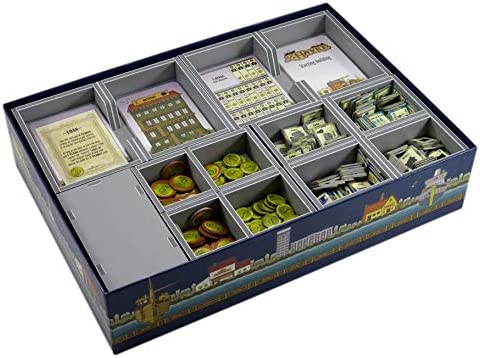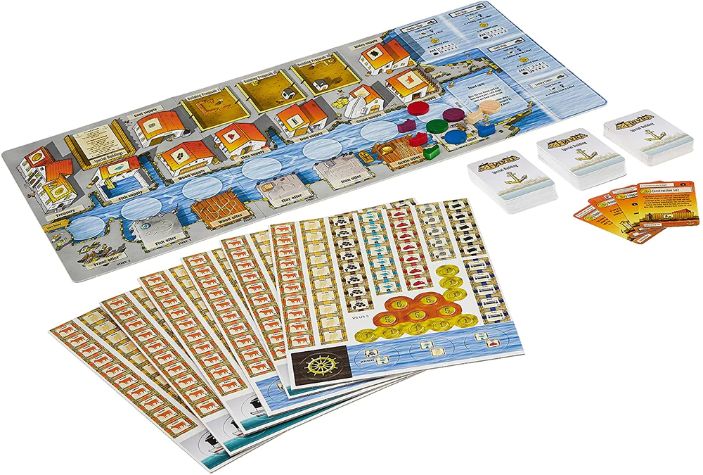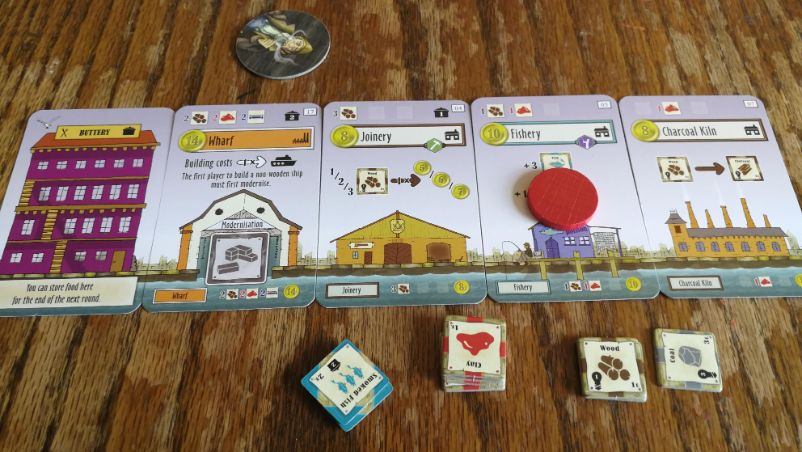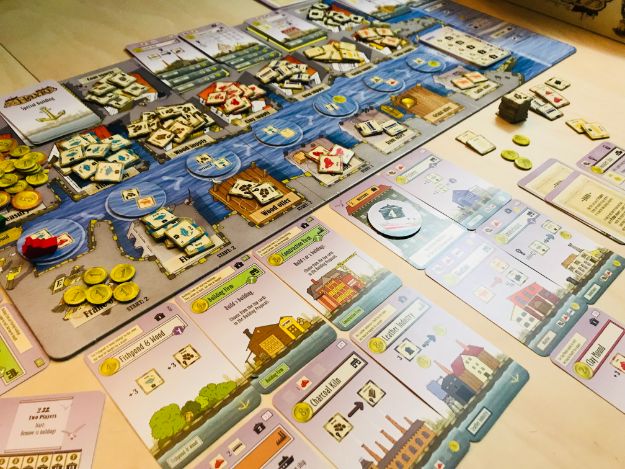Le Havre might be the ideal resource-shuffling game. It is a tightly wound web of options and choices that unravels and unfolds as you play. Ways to process, use, obtain, and sell as many goods as you can are available through a complex and ever-growing roster of buildings. The board is covered in tiny, square, double-sided tokens that are begging for you to take them before someone else does. They are spilling out of warehouses that are bursting with potential.
We’ll look at the Le Havre board game’s rules in this article. Please keep reading.
What Is Le Havre?
Le Havre is the second-largest harbor in France and is located in a French city. Simple rules govern this game. A player has two steps during their turn: distribution of newly supplied goods onto the offer spaces, and then action. Players can take every item of a type from an Offer space or use one of the buildings as a choice action.
With the aid of building actions, players can upgrade their possessions, sell them, or construct their own homes and ships. Players must pay an entrance fee to use a building they do not own, making buildings both an investment opportunity and a source of income. Ships, on the other hand, are mostly utilized for feeding workers.
Players must feed their workers every seven turns, and a harvest increases their grain and cattle reserves. After a specific number of rounds, each player may take one final action. The value of a player’s ships and buildings is added to their cash reserves. Those with the biggest fortunes win.
You can check out more information we have on other board games, such as Stardew Valley, Smash Up, Stratego and Summer Camp.
Setup
Le Havre’s setup is almost as important as the gameplay itself, but that setup also makes the game replayable.
Some key elements of setup are:
- The building cards should be evenly divided into 3 decks, and each deck should be placed face-up on the center board with the lowest number at the top. The top card of each stack is available to build or for purchase
- Shuffle turn marker spaces, then place face-down on the central board
- Decide on short vs. long game and sort out round cards as needed
- Place 3 starting buildings in the “village” in the center of the table. Depending on player count, there may be additional buildings to star
Game Flow
Le Havre is one of the simpler medium-heavy games we have covered on our site so far and is very approachable.
Depending on the number of players and whether you select the short or long game, the number of rounds varies. The 2-player long game consists of 14 rounds, while the 2-player short game consists of 7 rounds. Every round, regardless of the number of players, has exactly 7 turns.
Each player will receive an uneven number of turns per round due to the round’s round structure, and the starting player will automatically switch each round. In a game with two players, for instance, the player who starts first will have four turns, while the player after them will have three turns. The second player’s fourth turn will start the following round.
Game Turn
A player’s turn consists of two Mandatory actions and one or more Additional actions that are optional. Players must perform a Supply action first, followed by the Main action. The player may also buy and sell at any time during their turn as additional actions.
I. Supply Action
New goods are delivered to the harbor and placed on the corresponding Offer space during each player’s first action.

In the direction of the arrow, the player who is taking the turn places his Ship marker on the following free Supply tile. The Supply tiles begin the game face-down in the first round and remain that way until they are occupied; after that, they are turned over and stay that way until the game is over, remaining in the same place.
Each Good or Francs supply tile has two different tokens displayed on it. The player takes one token from each of these Supply spaces and places it on the appropriate Offer spaces, standard side up. The goods token’s border identifies the standard side as such.
A ship is placed on the seventh Supply tile during the final turn of a round. The current Round card is resolved and turned over at the end of this turn. The next player’s Supply action on the first Supply tile then starts the first turn of the subsequent round.
Interest for Loan cards: The word “Interest” is written on one of the seven Supply tiles: Regardless of the number of loans a player has, every player who has taken out a loan is immediately required to pay exactly 1 Franc in interest whenever a ship is placed on this tile. If a player is unable to pay this Franc, they must either sell a ship or building or obtain another loan card before paying the Franc.
Ii. Main Action
The Supply action is followed by the Mandatory Main action. The player whose turn it is selects one of the two Main actions: Use a building action or Take items from an Offer space.
Main Action A: Take Goods From An Offer Space
The player selects one of the seven Offer spaces and takes all Goods or Francs tokens.
The volume of a personal supply is unrestricted. All merchandise and Francs must be laid out face up and cannot be kept a secret from the other players.
Main Action B – The Building Action
Entering a Building: The majority of the building cards enable visitors to perform an action, such as to build additional buildings) or to convert standard goods to upgraded goods. A player must enter the building, or move her Person disc to an empty building, in order to use a building’s action.
Buildings that are owned by either the town or another player are accessible to players.
Page 6 and the overview of buildings provide an explanation of buildings.
Entry Fee: When using another player’s building, there is frequently a fee; this is indicated at the top right of the building card (between the building costs and the Sort order number). Before entering and using the building, the owner of the property must be paid, either in food or in Francs.
A player only pays one of the costs if the food and money costs are separated with a slash (/).
If a player is unable to pay the entrance fee, she is not permitted to enter the building.
The action of the building must be completed by a player who enters it.
Note: In this game, Francs can always be used in place of Food 1:1. But food can never take the place of francs.
Iii. Additional Actions: Buying And Selling
Buying
A player can purchase one or more Building and/or Ship cards at any point during his turn, even before performing the Supply action or the Main action. This is in addition to the Supply action and the Main action.
Buildings: All buildings owned by the town and those at the top of the three piles of building proposals are always up for sale. Most of the time, the purchase price is the building’s value; if it is not, the purchase price is listed separately (under the value, as “Cost”) A player may sequentially purchase multiple buildings from the same building pile.
Ships: Each ship pile’s top face-up card must be purchased in order to play. Each ship has a cost that is greater than its value and is listed below the value, just like on the building cards.

Note: Since wharves are only needed to construct ships, ships can be purchased even if no wharves have been constructed yet.
Selling
The town may also purchase buildings and ships. These actions may even be performed during the turn of a different player, but not when that player is performing an action. Ships and buildings are sold for 50 percent of their original cost. Buildings that are sold by players are added to the town’s collection of structures. When a player sells a ship, it is added to the top of the stack of cards with that type of ship on it.
Notes
When a building is purchased or sold, any personal discs attached to it are always returned to the player. (Sending the people home.
The same game turn cannot be used to sell a building and then buy it back.
Ships and structures can’t be sold to other players.
Iv. Buildings
Constructing New Buildings
New buildings can be built using the “Construction Firm” and the two “Building Firms”. The town owns these structures at the beginning of the game. By paying the building costs for the new building, a player who enters one of these structures can construct any of the top buildings in the Building Proposals area.
The necessary construction supplies are listed at the top of the building card (and are listed again at the bottom).
Be aware that steel can always be used in place of iron and brick can always be used in place of clay.
The Buildings overview, which includes a complete list of all building cards, contains additional explanations of the building cards.
Building Ships
The amount of food that a ship’s owner must pay at the end of each round is reduced by ships.
A new Ship card is added to the game at the conclusion of each round when the Round card is turned over. These ships might be constructed at one of the wharves (one ship per visit).
A player must first pay any required entry fees to the Wharf owner before paying the building resources and 3 energy needed to construct a ship (see Ships on the back of the Round cards). Wood (which can be upgraded to charcoal) and coal (coke) are the two sources of energy used by the players.

Special Case: The first player to construct an iron, steel, or luxury liner at a specific wharf is required to modernize the wharf by laying one brick on it. For the duration of the game, the brick is still on the wharf to demonstrate that it has been updated to accommodate all players. A Wharf can only be modernized by a player who is building a ship. Modernizing a Wharf doesn’t require the player to own one.
Ships are very important! It is crucial to this game that you plan ahead to meet your food needs. The building or even purchasing a ship early on in the game is advised for players who do not take a lot of grain or cattle at the beginning of the game because it is possible that they will spend the majority of the game merely attempting to obtain food. Building ships is crucial for all players in the long run. In essence, without ships, the game cannot be won.
End Of Round
The round is over once any player has finished their turn and reached the seventh round marker.
To the seventh space, only one player must advance.
In most rounds, players will take a harvest action, taking 1 grain if they have any grain and 1 cow if they have more than 2 cows.
You obviously need to feed your people because it’s an Uwe game. Food is a crucial component of your strategy because each round calls for more and more of it. Unlike other Uwe games, you have no control over the total amount of food “due” (each player must pay the same), but you have a number of ways to come up with it.
The ship will be visible on the other side of the round card once you have finished feeding. As long as the wharf is removed, the ship can now be built in the following round.
End Of Game
The number of rounds in the game varies depending on the number of players and whether you chose a long game or a short game. The round number is indicated on the round cards, and there is a summary card available for each player count that details any potential special circumstances surrounding that round.
The winner is the one with the most money, including the value of their buildings.
Pro-Tip: Constantly remember that the final score is determined by the amount of money invested and the value of the building. Make sure you have a plan for what to do with all that clay and that the math is in your favor if you’re investing time and money into building a nice clay engine. It’s simple to get focused on building an engine and overlook the possibility that investing all of your money in a cool building might not be worthwhile in the long run.
